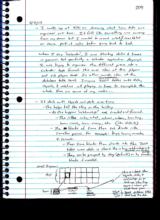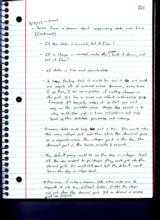|
Basic Assignments
|
Options & Settings
|
Main Time Information
|
||||||||||||||||||||||
|
|
|
|
|
||||||
|
||||||
|
|
|
Notes:
|
|
-I woke up at 4:00 am dreaming about how data was organized over time. It felt like something was missing from my dream but I wanted to record what I scribbled on some post-it notes before going back to bed. When I say “calendar”, I was thinking dates and times in general. Not specifically a calendar application. Anyways, I was trying to organize the different pieces into a calendar type format. This was clear at the players and sub players level. In other words, clear at the database table level. Imaging 200+ (two hundred plus) tables with data, objects, and relations all playing in time to complete the whole. Here are some of my notes… -It starts with objects and data overtime - This helps tell the story or the history o As this happens “relationships” are created and formed. * This is the who, what, where, when, how long, how much, how many, etc. (aka details) o The blocks of time then sub divide into smaller pieces. For example: Days, hours, minutes, and seconds. * These time blocks then divide into the 200+ tables were data is stored. This is how relationships are formed in a digital world. * They can be grouped by day (default) or by smaller blocks if needed. (Small diagram: in notebook) (This is where the objects, data and relationships go or end up. This tiny square is where you could have your 200+ database tables that hold the data.) Notes from a dream about organizing data over time. (Continued) -Anyways, I was seeing the database tables holding data clear down at the second level. This is kind of deep but it felt like the best spot for it. Prior to this dream, I’ve always envisioned the database at the day or daily level. However, it feels like it needs to go even deeper. Basically, at the day level, there are too many variables (too big of a time span). If you took it clear down to the seconds you could always go back up and sum things up by the minute, hour, day, month, year, etc. -If you take things clear down to the second level, without freaking out or overwhelming, your users, you get? - This produces the story, the history, and the ability to track objects and data over time. - Time becomes the constant piece to ride on. - It comes back to – all data is live and searchable. - This also allows for groups, edits, changes, flex, corrections, etc. - It allows us to convert data (virtual water) water-slush-snow-ice. - This also creates the “life cycle” -It circles back to tracking objects and data over time. -Enter once; use it over and over again. -If the data is correct, let it flow! -If a change is needed, make the change, lock it down, and let it flow! -All data is live and searchable. -I keep thinking that it would be cool if we could run reports off of archived values. However, every time I go there, I can see a problem if anything changes in the past. It has a cause and effect relationship going forward. It basically makes it so that you can’t rely on the archived values. Maybe the secret is to start with the just in time calculation and help speed up the database processing and indexing. -Numeric dates could help out a ton. You could index the main integer part and then store the decimal part as a separate value. The integer part is the day; the decimal part is the hours, minutes, and seconds. -The default group would be on the day or integer level. If the user needed to go deeper they could get into the decimal part. It would still exist but the default would be on the day or integer level. -Either way, if using a numeric date value, make sure to separate it into two different fields. Index the integer and just store the decimal part. If no decimal is needed, just use 0 (zero). -I had some fun ideas about adilas university the other day. It was kind of a cross between adilas and LTF and using a non-linear Flash type interface. I also thought about simple HTML Frames, sub menus, etc. -Some diagrams in the notebook: -each link from the simple page would load in a new menu on the frame set. -a click from the frame-set menu would put a video into the player. -Another idea was an app of sorts that uses the screen area to show everything. Unlike LTF that had a skin and a player, this little app would be just a player and then skin itself on top of the player section. Basically a way to conserve space. This would be nice for mobile stuff. (Player with a small wrapper) (Player with a menu) |




